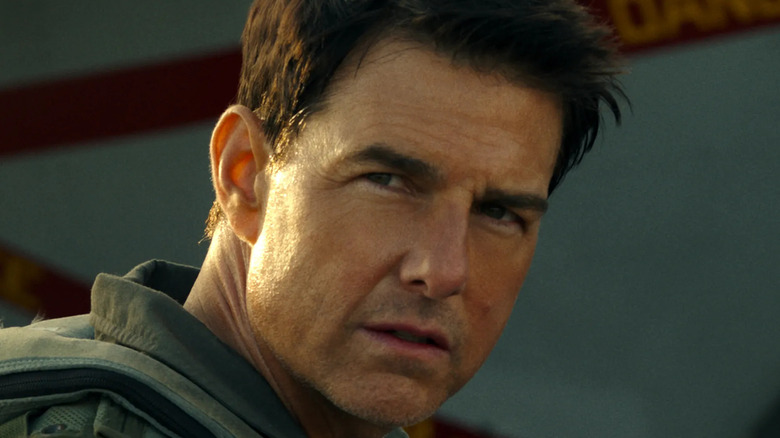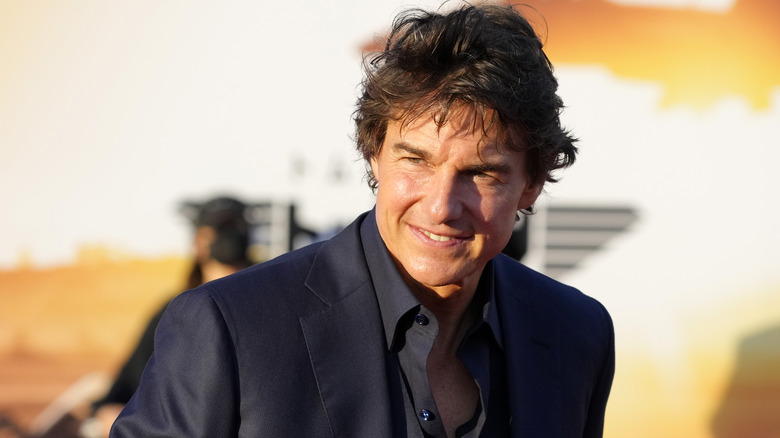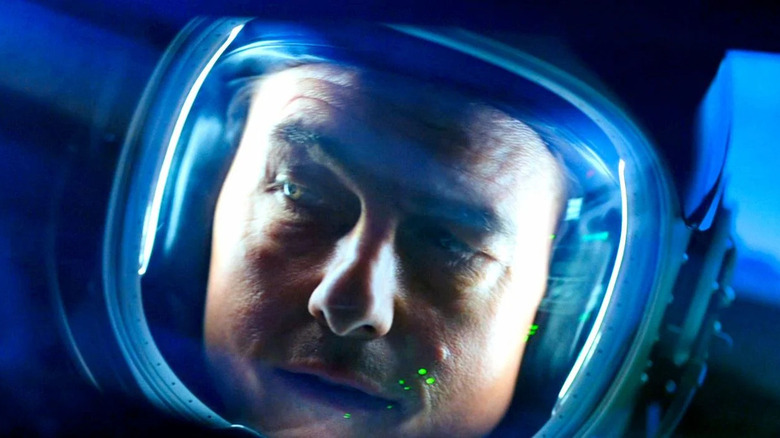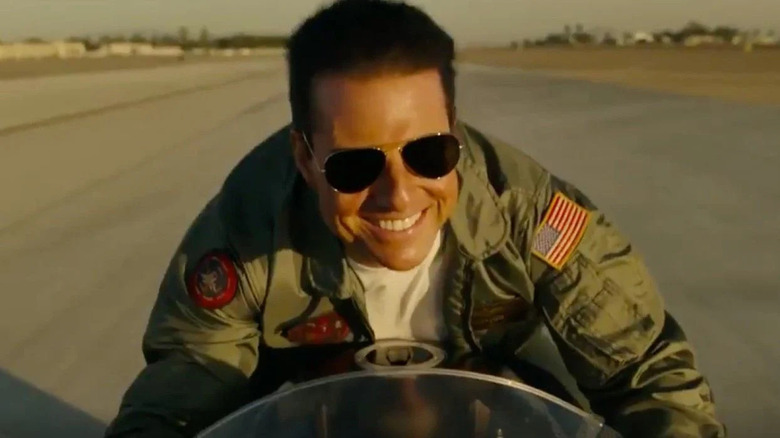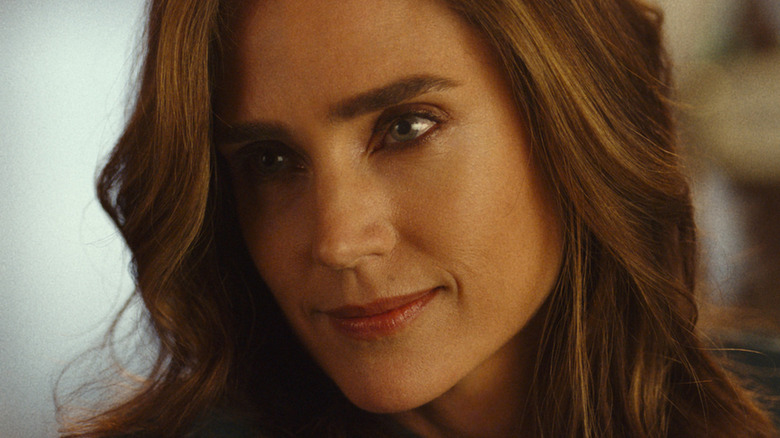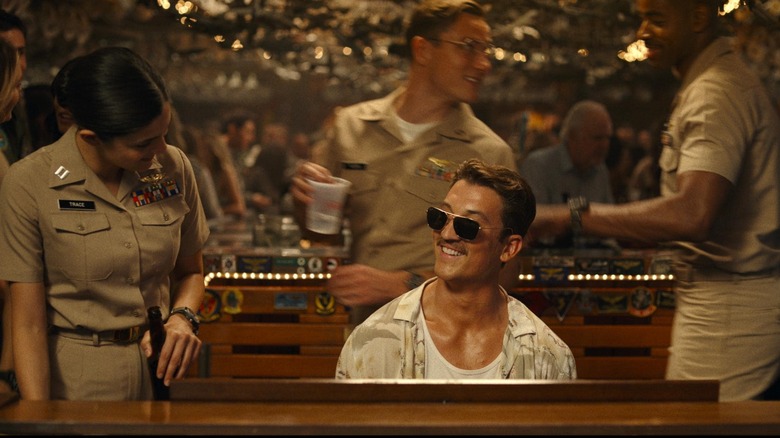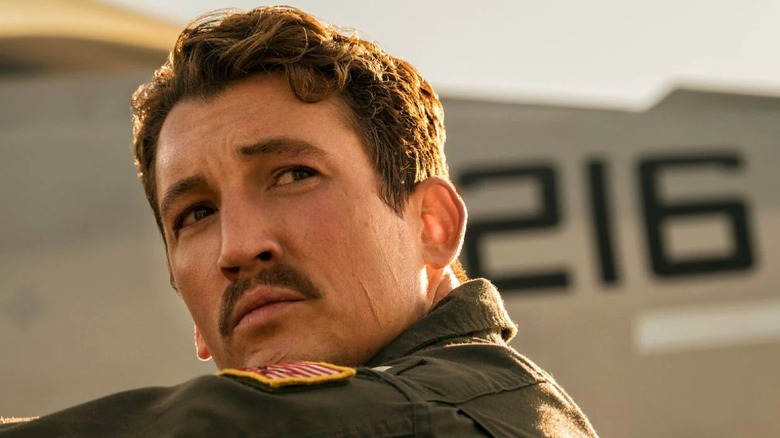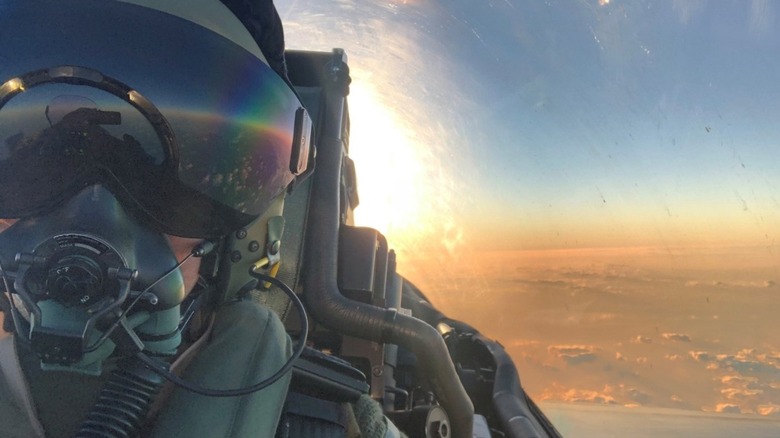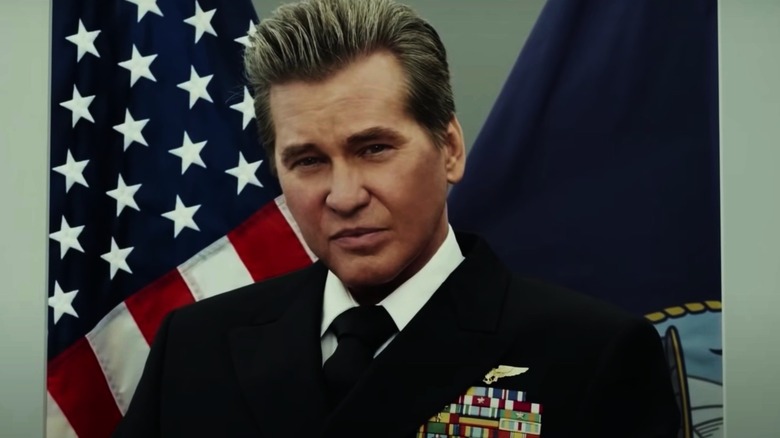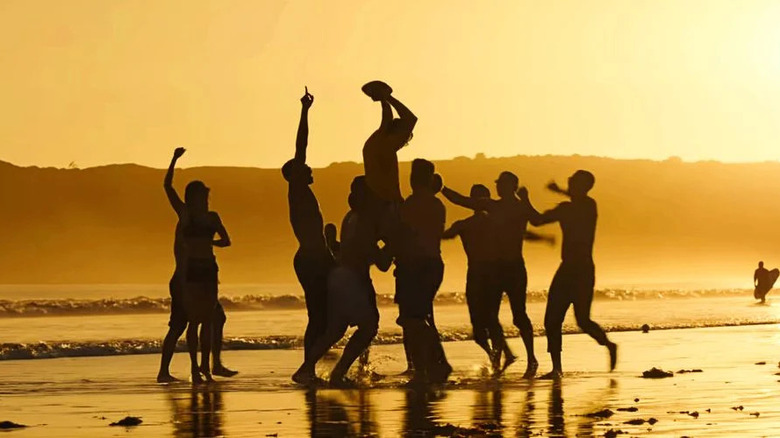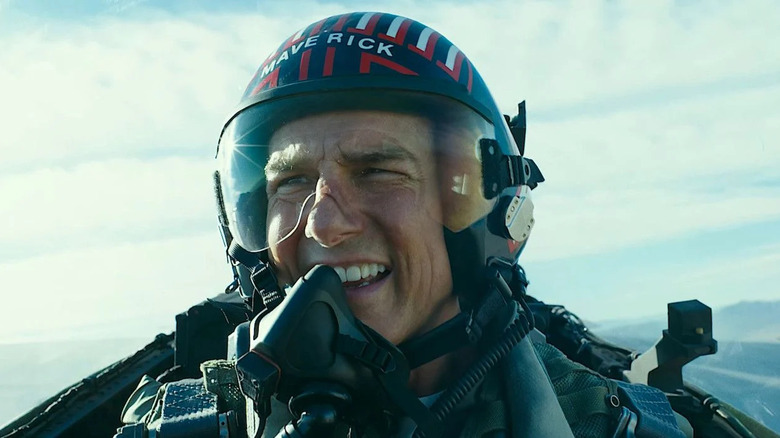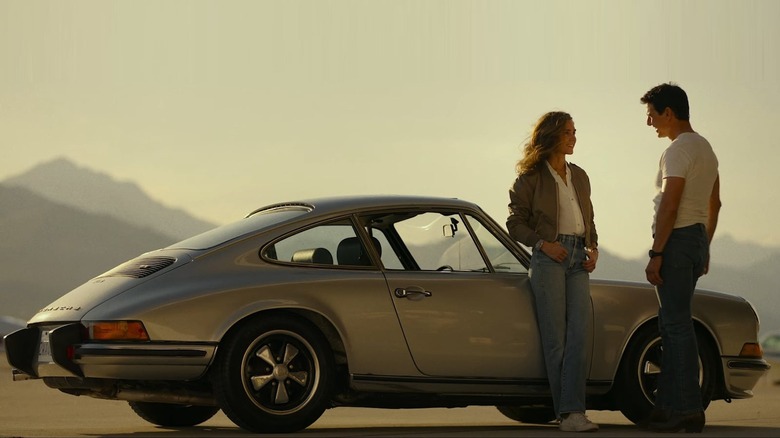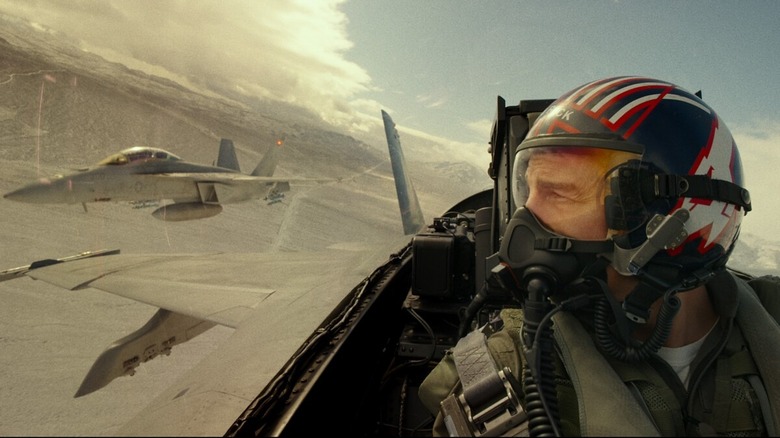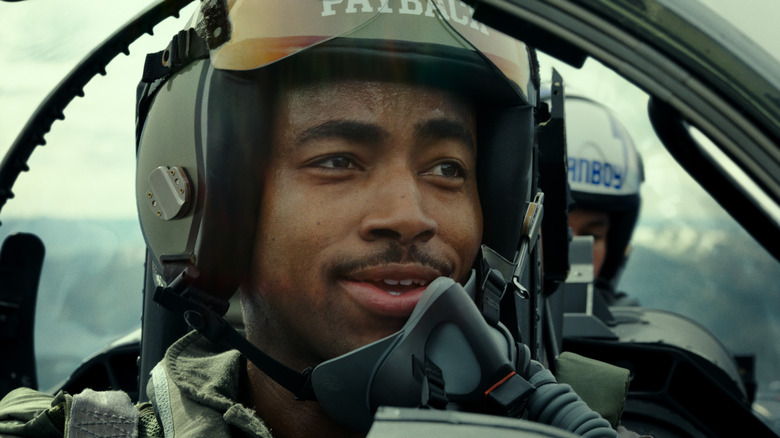Small Details You Missed In Top Gun: Maverick
Chances are, you've seen "Top Gun: Maverick" by now. The film — which premiered to rapturous applause at CinemaCon and then received a 5-minute-long standing ovation at the Cannes Film Festival — landed in movie theaters over Memorial Day weekend and broke box office records. With over $300 million in domestic box office receipts after less than two weeks, "Top Gun: Maverick" is already the highest-grossing film of Tom Cruise's entire career. Cruise is one of only a few remaining movie stars of his caliber, so that's saying something.
Critics and moviegoers alike agree that the long-awaited legacy sequel surpasses its already-popular predecessor. But part of the fun of "Top Gun: Maverick" is the way it blends nostalgia with cutting-edge practical filmmaking techniques. It's been more than 35 years since the first "Top Gun" introduced audiences to Maverick, Goose, and Iceman, so you can be forgiven if you didn't catch every single one of the many callbacks to the original, especially considering the action-packed sequel moves at a pretty fast clip. Some are blink-and-you'll-miss-them references. Others are hidden (and sometimes not-so-hidden) tributes to the previous cast and crew. In case you didn't notice them all on your first pass, these are all the meaningful details in "Top Gun: Maverick." (Beware, you're about to enter the danger spoiler zone.)
Some audiences saw a personal message from Tom Cruise before the movie
Before "Top Gun: Maverick" took off, some moviegoers got to see producer and star Tom Cruise delivering an earnest, heartfelt prerecorded message. Looking directly into the camera, an enthusiastic Cruise says in this footage, "Hi everybody and welcome to "Top Gun: Maverick." Thank you all for being here. Decades in the making and so many people — our incredible cast and crew — worked very hard to bring you the most immersive and authentic film experience we could. There's real F-18s, real Gs, real speed. We're so happy you're here in this theater and seeing it on the big screen, so please enjoy as we all made it for you."
These types of introductions are extremely rare, and this one, in particular, is loaded with backstory and meaning. By reaching out to the theatergoing audiences, Cruise is priming viewers to have the best possible experience watching "Top Gun: Maverick," but he's also explaining the film's extended delay and its importance to the future of the entertainment industry.
"Top Gun: Maverick" was scheduled to premiere in 2019 but was pushed back to 2020 to allow for more time to stage its complex action sequences. When the COVID-19 pandemic led to theater closures before the film's release date, Cruise and co-producer Jerry Bruckheimer turned down lucrative offers that would've sent the movie straight to streaming. They stuck to their guns through even more delays, believing that "Top Gun: Maverick" had to be a communal, cinematic experience. The newly-minted blockbuster's ticket sales proved them right.
The opening scene is an homage to Tony Scott
Director of the original "Top Gun," Tony Scott, died by suicide in 2012. At the time, a script for a "Top Gun" sequel was in development, but the project was shelved after Scott's death. The eventual director of "Top Gun: Maverick," Joseph Kosinski, decided to faithfully recreate the 1986 film's opening sequence as a "tip of the hat" to Scott's previous excellent work.
The first scene will feel familiar to anyone who's seen "Top Gun," so much so that you might think projectionists loaded the wrong movie. First up is a black and white title card. Then, silhouettes of crew members ready a plane for takeoff as a booming score gives way to the guitar riffs of Kenny Loggins' "Danger Zone." The only differences come in the way of the actors (with the exception of Cruise) and the planes. In the original, Maverick flew an F-14. This time, he's test piloting a fictional craft called the Darkstar that looks to be inspired by an SR-71 Blackbird.
Kosinski explained to Entertainment Weekly that he so heavily referenced the former film because he "wanted that first few minutes to just tell you, this is a 'Top Gun' movie [and] we love it as much you do." He also credited Scott with inventing not only the visual style of the first "Top Gun," but of the modern action movie, and Kosinski wanted to pay homage to him.
If you or anyone you know is having suicidal thoughts, please call the National Suicide Prevention Lifeline at 1-800-273-TALK (8255).
Maverick's still got his old gear
So it goes for the film, the props, and much of the "Top Gun: Maverick" dialogue and story beats: everything old is new again. When Maverick gets shipped off to the Naval Air Station North Island where he'll serve as an instructor instead of a test pilot, he reaches for his old aviator sunglasses, helmet, jacket, and motorcycle. Sharp-eyed fans of the original will recall the costume pieces and the Kawasaki Ninja motorbike from 1986's "Top Gun."
These aren't just Easter eggs for the sake of fan service. In the film, it's clear that some of Maverick's compatriots (including Jon Hamm's Vice Admiral Beau "Cyclone" Simpson) don't respect him because he doesn't seem to have matured, and he hasn't advanced in his career. While his contemporaries have risen through the Navy's ranks, many pilots Maverick's junior now outrank him, as he's still a captain after more than 30 years. The fact that Pete Mitchell still wears the same gear and rides the same bike is a symbolic reflection of the fact that he's kind of stuck in the '80s, too. Before the film's adrenaline-pumping climactic final act, Maverick comes clean to Cyclone that he didn't really want to teach and that he's avoided promotion so he could stay in the air instead of behind a desk.
Penny is the Admiral's daughter
Kelly McGillis, who played instructor Charlie Blackwood in "Top Gun," didn't return for the sequel. That meant Maverick needed a new love interest in the film. But rather than create a character out of thin air, filmmakers decided to bring to life an old reference. Jennifer Connelly is Penny Benjamin in "Top Gun: Maverick," a single mom and owner of the Hard Deck bar with whom Maverick appears to have had past entanglements. Their relationship gets a fleeting mention in an early scene of "Top Gun" when Goose teases Maverick about having "a history of high-speed passes over five air control towers and one admiral's daughter."
Penny is the admiral's daughter in question. Goose drops her name in the original and adds that her dad went "ballistic" over their fling, which would've predated Maverick's time spent with Charlie. Since we don't see or hear how, exactly, Charlie and Pete's romance fizzled out, we're left to conclude from Penny's comments that Maverick has trouble committing. She talks about their history as if they've been on and off again several times for several decades, and the way her daughter, Amelia, treats Maverick suggests he's hurt her mother more than once. The old cad is still sneaking out of her window at the halfway point of the film, but as he does, he promises he'll never leave her again. We'll have to wait for "Top Gun 3" to see if he keeps his word.
The bar scene features a role reversal
In many ways, "Top Gun: Maverick" is more like a remix of "Top Gun" than a sequel (and unlike what Cyclone says to Maverick, that is a compliment). Since the follow-up takes place a full generation later, there's a satisfying thematic resonance to seeing similar scenes play out with slightly altered outcomes. One such scene occurs when Maverick visits the Hard Deck and attempts to flirt with Penny. When he (in her words) disrespects her, she rings a bell and announces to the patrons that the next round is on Mav.
The newly arrived cadets — including Hangman (Glen Powell), Phoenix (Monica Barbaro), and Rooster (Miles Teller) — spot the nearly 60-year-old Maverick at the bar and thank the old man for the drinks. There's noticeable condescension in Hangman's voice. Moments later, when Mav doesn't have enough cash to pay his tab, she rings the bell again as the bar full of servicemembers chants "overboard." The pilots pick Maverick up and toss him out of the establishment, and an only slightly deterred Pete becomes wistful as he watches his late friend's son, Rooster, perform "Great Balls of Fire" at the piano.
The next morning, Hangman and the others arrive for training to find that the man they mocked and threw out on the street the night before is actually their instructor. This entire sequence is a reference to the bar scene in "Top Gun" but with roles switched. Hangman is now the cocksure youngster, Rooster (as styled, Teller bears a striking resemblance to Anthony Edwards) is the stand-in for Goose, and Maverick has replaced his old flame, Charlie, as the incognito teacher.
Rooster's call sign is a nod to his dad
Maverick is furious when he discovers that Bradley Bradshaw, the son of his former wingman, is among his new pool of trainees for what's guaranteed to be a death-defying mission. Rooster's fellow pilots pick up on the tension between him and their instructor, and they figure out why partway through the film, thanks to a helpfully labeled old group picture. It turns out that the young Mr. Bradshaw doesn't blame Pete Mitchell for his father's death, and "Top Gun: Maverick" is much better for that storytelling choice. Instead, Rooster is angry with Maverick for pulling his name from Naval Academy consideration, which he believes cost him four years of his career.
Maverick did keep him out of combat for as long as possible, as he promised his mother, Carole (Meg Ryan), he would do on her deathbed. Mav doesn't want the boy to hate his mother, so he keeps his reasons a secret. But Rooster, who clearly looks up to his father and wants to emulate his bravery, can't be deterred. His call sign — Rooster — is almost certainly a tribute to his dad. Both roosters and geese are types of fowl; Bradley would've obviously chosen Rooster over something like Chicken or Turkey, both of which can be used as slang to indicate fear. Rooster is the most cautious out of all 12 cadets, but he is the only one who makes it to the target during training.
The enemy is never named
It's no secret that the United States Navy played nice with the cast and crew of both "Top Gun" and "Top Gun: Maverick," giving them unprecedented access to equipment because they saw the movies as inspirational potential recruitment tools for prospective pilots. It worked the first time; enrollment went up 500% after "Top Gun" hit theaters, and the branch is hoping for another boost in response to the sequel. While what's now the "Top Gun" franchise is unabashedly patriotic, it's not really propagandist in any other way besides being pro-the valor of military service. Both films are almost entirely apolitical. In fact, the enemy is never actually identified in either one.
This time, the anonymous bad guys are on the wrong side of NATO, enriching the uranium for a nuclear weapon in treacherous, snowy mountain terrain. They fly "fifth-generation fighters" (the planes used for filming are modified Russian SU-57s) that are superior to their own planes, making the mission even more dangerous. Critics, fans, and geopolitical experts have made educated guesses as to which country is the aggressor. Russia and China have fifth-generation fighters and snowy mountains, but they also already have nukes. North Korea and Iran are in similar stages of weapons development but don't have the aircraft in question. And escalation with any of these nations would likely plunge the world into war. It's probably best to think of the enemy as fiction. There are myriad narrative and diplomatic advantages to keeping things vague; the audience can focus on the core characters and the action at hand, the lack of specificity helps writers avoid errors and plot holes, and there's no unnecessary international ill will.
Iceman's story reflects Val Kilmer's real health struggles
In addition to Cruise, Val Kilmer reprises his role as Tom "Iceman" Kazansky. The film implies that he and Maverick stayed close after the harrowing finale of "Top Gun," but that Iceman rose through the ranks to become a four-star admiral and commander of the Pacific fleet while Maverick remained stuck at the rank of Captain. When he fears that his latest stunt will finally ground him for good, Penny assures him that Iceman will make a call and get him out of trouble... again. Cyclone also warns Pete that he's only in his position because Commander Kazansky wants him there.
In the first third of the film, Iceman and Maverick communicate via text. When Iceman sends a message that he needs to see Maverick, the latter replies that it's not a good time. That's when Iceman insists text back that he's not asking. Maverick arrives at his home, and it's obvious he's not well. His wife tells Pete that it hurts him to even speak. The former flyboys have a touching reunion in which Iceman uses a computer to type his advice to a troubled Maverick. He tells him to let go of Goose's death and train his son for combat. Before mission prep is complete, Maverick gets the call: Iceman has succumbed to his illness.
In real life, Val Kilmer has been battling throat cancer since 2017. The veteran actor lost his voice as a result. Cruise couldn't imagine a "Top Gun" sequel without his friend, so he convinced him to participate, and the character's arc was written to be respectful to both Iceman's legacy and Kilmer's situation. The character's voice is a combination of Kilmer's son's spliced with previous recordings of the actor.
Dogfight football replaces volleyball for team building
In the first "Top Gun," the cadets learn the value of teamwork (and give the audience a break from the classroom and the cockpit) with a volleyball game, sans Val Kilmer and Tom Cruise's shirts. Director Tony Scott got himself in hot water for the scene, which was only a short paragraph in the script. Paramount was so angry that Scott spend a day's time and money on the volleyball game that they considered firing him. In the end, the volleyball interlude became one of the most iconic moments in the movie.
In "Top Gun: Maverick," Cyclone tells Mav to assemble a team, but as the mission date gets moved up, he's frustrated with the cadets' progress. Rather than devote more hours to practicing their route, the reluctant instructor challenges his squad to a friendly but spirited game of dogfight football. He explains it's the same as regular beach football, but with both sides' offense and defense running at the same time. Basically, it's fun chaos of the sort that 12 fierce competitors can bond over, and even Cyclone can see that it's working.
The dogfight football scene is the moment that Hangman and Rooster see beyond their differences, but it's also another allusion to the original "Top Gun" and another acknowledgment of Tony Scott's influence.
Maverick buzzes the tower again
Another memorable moment from 1986's "Top Gun" comes at the end of Maverick's first training hop in Miramar. The young hotshot pilot manages to defeat his trainer, Jester, but he flies below the hard deck and breaks the rules of engagement to do so. He celebrates as he buzzes the tower, even though they denied his request. His superiors admire his skill but admonish him for his recklessness.
The Pete Mitchell we see in "Top Gun: Maverick" is about 35 years older and at least a little wiser, but he still can't help himself from throwing caution — and orders — to the wind. In the film's gripping opening scene, Mav is dismayed that Read Admiral Hammer is on his way to shut down his Darkstar program early. Since they haven't proven that the jet is capable of sustaining 10Gs, Hammer plans to divert their budget to drones. Maverick jumps into the pilot's seat and pushes the Darkstar past its limits, reaching the elusive milestone but destroying the expensive piece of government equipment in the process.
He pulls a similar stunt when Cyclone is about to send his still-unprepared cadets into enemy territory. Phoenix doubts that the mission is even possible, but Maverick completes it without crashing or getting shot down by simulators with less than a second to spare. Afterward, he buzzes the tower (this time, without asking permission) as an entertained Hondo and an annoyed Cyclone look on.
Maverick's love interests both drive Porsches
Pete Mitchell really has a thing for women who have a thing for Porsches. In "Top Gun," his instructor and the object of his affection could be seen behind the wheel of a black 1958 Porsche 356. That vehicle was actually a replica, made especially for the film by a Canadian company called Intermeccanica. In "Top Gun: Maverick," bar owner and on-and-off girlfriend Penny drives a 1973 Porsche 911 S. This time, filmmakers were able to secure the real thing. Car collector Nick Psyllos lent his to the production, and a model E was kept on set as a backup.
"Penny sails fast boats, so I liked the idea that she drove a vintage Porsche as well," director Joseph Kosinski told Fortune Magazine, adding, "I think the 1973 911 S model is one of their most timeless designs." Jennifer Connelly operated the vehicle herself during the shoot. Business at the Hard Deck must be good; a mint condition 1973 Porsche 911 S can go for more than $200,000.
Top Gun: Maverick and Star Wars: A New Hope have a lot in common
"Star Wars" fans who went to theaters over Memorial Day weekend to see "Top Gun: Maverick" may have noticed some curious parallels between Maverick and company's mission to explode the uranium target and Luke Skywalker's heroic effort to destroy the Death Star. Pete is trying to prepare his team for a job that'll require two miracles to pull off. First, they must fly low — around 100 feet in altitude — n through an icy cavern full of switchbacks guarded by defense missiles turrets. Then, they must hit their target, twice, while reaching speeds of up to 10Gs escaping the blast, the sharp peaks, the missiles, and any potential enemy aircraft in their more advanced fifth-generation fighters.
In "Star Wars: A New Hope," Luke Skywalker and his fellow X-Wing pilots have to fly their spacecraft (which are also inferior to the enemy's) through the Death Star's labyrinth-like trenches until they reach their equally tiny target, a thermal exhaust port which they have but one chance to hit with a proton torpedo. Both the unnamed foreign pilots and the Empire's troops' faces are completely hidden behind black helmets. And when Maverick and Goose are shot down and ejected into the wilderness, Hangman comes to their rescue at the last second in much the same way Han Solo did for the Rebels. Unfortunately, Luke loses some of his wingmen in the Battle of Yavin, but this time, Maverick is able to complete their task and bring the whole team home.
Famous phrases from the original find their way into the script
"Top Gun: Maverick" isn't a shot-for-shot and word-for-word remake of the original, but in addition to several sequences that closely mirror the those of the first film, several lines of dialogue are referenced or exactly repeated. These don't feel like lazy writing choices; they're callbacks to significant moments and lessons learned from Maverick's younger days at TOPGUN.
Among the words of wisdom: Maverick tells Rooster, "Don't think; just do." This sentiment, which gets uttered a few times throughout the movie, comes from Maverick's "Top Gun" advice, "You don't have time to think up there. If you think, you're dead." Mav's line, "Too close for missiles, switching to guns," is also a close copy as are mentions about not dropping your wingman. One of the cadets who makes Maverick's team, Payback (Jay Ellis), repeats the phrase "turn and burn" from the original.
It would be impossible not to retread some of the words and sayings that "Top Gun" made famous. After all, terms like Hard Deck are used by real aviators every day.
